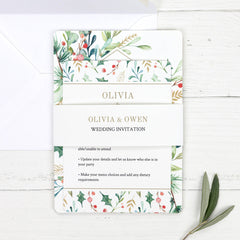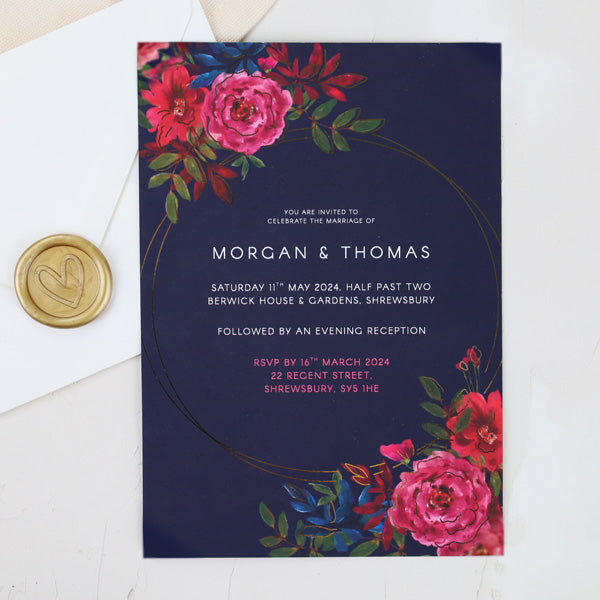What to Include on Your Wedding Guest Information Cards

Planning a wedding involves a long list of details, and one of the most thoughtful things you can do for your guests is provide them with all the practical information they’ll need in one place. This is where wedding guest information cards come in. These small but mighty inserts can save your guests confusion, prevent repetitive questions, and ensure the day runs smoothly for everyone involved.
Rather than cramming all the details onto your main invitation, guest information cards allow you to share everything your loved ones might need to know, presented clearly and beautifully in line with your wedding theme.
What Is a Guest Information Card?
A guest information card is a separate enclosure included with your wedding invitation suite. It contains important logistical and practical information that goes beyond the basics of the ceremony details.
These cards are particularly useful for weddings with travel involved, overnight stays, or a multi-day schedule. They also help set expectations around attire, transport, timing, and more.
Why Include a Guest Information Card?
Keep Your Invitations Clean
Your main wedding invitation should stay focused on the essential details: names, date, time, and venue. Including everything else—like dress codes, parking, and accommodation—can make the invitation look cluttered and difficult to read. A guest information card gives you space to share all the need-to-know extras.
Save Guests from Uncertainty
The more your guests know ahead of time, the more comfortable and confident they’ll feel. Clear instructions and guidance allow them to plan accordingly, whether it’s what to wear or where to stay.
Reflect Your Planning Efforts
You’ve put a huge amount of effort into planning your day. Guest information cards show that you’ve thought through the details and that you value your guests' comfort and experience.
What to Include on Guest Information Cards
Here’s a breakdown of the most common and useful details you may want to include:
1. Venue Address and Directions
Even if your venue is well known, providing the full address and directions helps avoid any confusion. For more remote venues, consider including nearby landmarks or postcodes for sat navs. If you're using two venues for the ceremony and reception, be sure to include both.
2. Transport and Parking Info
Let guests know about parking arrangements, shuttle services, or any public transport options. If your venue has limited parking or requires permits, make that clear in advance.
3. Accommodation Suggestions
Offer a shortlist of nearby hotels or B&Bs—especially if guests are travelling from out of town. You can include links or discount codes if you’ve reserved blocks of rooms, or suggest a variety of options to suit different budgets.
4. Dress Code
Set expectations by stating the dress code (formal, cocktail, smart casual, black tie, etc.). You can also mention any practical considerations, such as wearing flat shoes for a garden ceremony or bringing a jacket for a chilly barn venue.
5. Day Schedule
Let guests know what to expect throughout the day. This could include:
Ceremony start time
Reception or drinks arrival
Dinner and speeches
Evening entertainment
Carriages (end time)
If timings are approximate, make that clear.
6. Gift List or Registry Information
Although some couples prefer to include gift list details on a separate card, it’s fine to mention it here with a polite note. Keep it light and gracious—something like:
“Your presence is present enough, but if you’d like to give a gift, we’ve put together a list at…”
7. Children and Plus Ones
If you’re having an adult-only event or limiting plus-ones, the guest information card can gently communicate this. Try:
“We kindly ask that this be a child-free celebration.”
“Due to venue limitations, we’re only able to accommodate those named on your invitation.”
8. Accessibility Notes
If any guests might have mobility or dietary needs, let them know who to contact in advance. You can also note if your venue has step-free access or accessible facilities.
9. Contact Details
Include a way for guests to get in touch with a designated person (like your wedding planner or a member of the wedding party) on the day if they need help.
10. Fun Extras
Some couples like to add a personal touch to their guest information card with things like:
A fun fact about the venue
Suggestions for local attractions
Weekend itinerary if you’re hosting more than one event
A QR code linking to your wedding website
Design and Print Tips
Guest information cards should match or complement your main invitation suite in terms of style, colour and paper. Keep the design clean and easy to read—especially if you’re including a lot of content. Avoid long paragraphs; bullet points or short sections work best.
If you’re using a double-sided format or printing on both sides, make sure the content is organised in a logical, visually pleasing way.
Final Thoughts
Guest information cards may seem like a small detail, but they can make a big difference in how smoothly your wedding runs. By anticipating the questions your guests might have and answering them ahead of time, you’ll help create a relaxed and enjoyable experience for everyone involved.
Whether you’re hosting a countryside celebration, a city soirée, or a weekend wedding retreat, these cards are your chance to share everything your guests need to feel prepared, welcomed, and excited for your big day.
Recommended Articles
UPDATED ON
November 06, 2025








